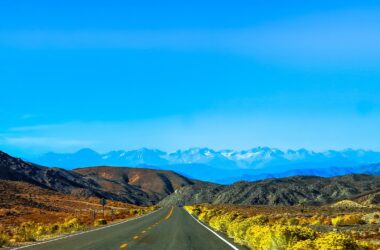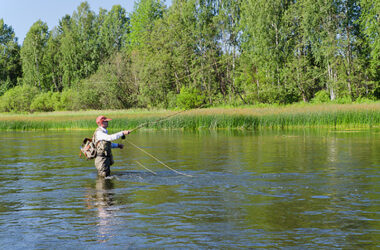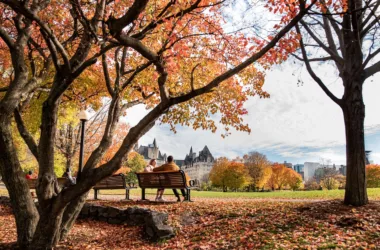Located in California, Death Valley National Park is one of the most unique and awe-inspiring places to visit in the United States. With its striking landscapes and diverse array of flora and fauna, Death Valley is a must-visit destination for nature lovers, hikers, and photographers alike.
In this article, we’ll explore the natural wonders and cultural history of Death Valley National Park, and provide tips and recommendations for planning your own visit.
Geography and Geology of Death Valley
Death Valley National Park is located in the Mojave Desert in eastern California, stretching over 3.4 million acres. The park encompasses a variety of landscapes, including salt flats, sand dunes, canyons, mountains, and valleys.
At the center of the park lies the lowest point in North America, Badwater Basin, which sits at 282 feet below sea level. The valley is surrounded by steep mountain ranges, including the Panamint Mountains to the west and the Black Mountains to the east.
Death Valley’s unique geography and geology have been shaped by millions of years of tectonic activity, erosion, and volcanic activity. The park is home to a variety of geologic formations, including ancient lava flows, sedimentary rocks, and salt deposits.
One of the park’s most famous geological features is the Racetrack Playa, a dry lakebed where rocks mysteriously move across the surface, leaving behind long trails in the dirt. Scientists have studied the phenomenon for decades, but the exact cause of the moving rocks remains a mystery.
Flora and Fauna of Death Valley
Despite its harsh environment, Death Valley is home to a surprising variety of plant and animal life. The park is home to over 1,000 plant species, including desert wildflowers, Joshua trees, and the rare and elusive Devil’s Hole pupfish.
The park is also home to a variety of wildlife, including bighorn sheep, coyotes, kit foxes, and rattlesnakes. Birdwatchers will be delighted to spot a variety of species, including golden eagles, roadrunners, and the endangered southwestern willow flycatcher.
One of the most famous plant species in Death Valley is the creosote bush, which is believed to be one of the oldest living organisms in the world, with some specimens estimated to be over 11,000 years old.
Human History of Death Valley
The history of Death Valley is just as fascinating as its geology and natural wonders. The park has been inhabited by various indigenous groups for thousands of years, including the Timbisha Shoshone, who still maintain a strong connection to the land.
In the mid-19th century, prospectors began to flock to Death Valley in search of gold and other precious minerals. The harsh conditions of the valley made mining a difficult and dangerous task, but some miners were able to strike it richly and establish successful mining operations.
The park is home to a variety of historic sites, including the ruins of the Harmony Borax Works, which was once the largest borax mining operation in the world, and the Scotty’s Castle complex, a grand estate built in the 1920s by a wealthy Chicago businessman.
Visiting Death Valley
If you’re planning a trip to Death Valley National Park, there are a few things you should keep in mind to ensure a safe and enjoyable visit.
First and foremost, be prepared for the harsh environment. Death Valley is one of the hottest and driest places on earth, with temperatures regularly reaching over 100 degrees Fahrenheit in the summer months. Be sure to bring plenty of water, sunscreen, and protective clothing to keep yourself safe from the sun and heat.
When planning your itinerary, be sure to prioritize the park’s top attractions
Top Attractions in Death Valley
- Badwater Basin: This stunning salt flat is one of the most iconic sights in Death Valley. The flat stretches for miles, creating a surreal and otherworldly landscape. Visitors can walk out onto the flat and explore the crystalline salt formations up close.
- Zabriskie Point: This viewpoint offers stunning panoramic views of the park’s badlands and canyons. It’s especially beautiful at sunrise and sunset when the colors of the rocks and sky create a magical glow.
- Mesquite Flat Sand Dunes: These towering sand dunes are a photographer’s dream. The dunes stretch for miles and offer endless opportunities for stunning landscape shots.
- Artists Palette: This colorful hillside is made up of a variety of minerals that create a stunning array of colors. The palette is especially beautiful in the late afternoon light when the colors are at their most vibrant.
- Ubehebe Crater: This massive crater was formed by a volcanic eruption over 2,000 years ago. The crater is over half a mile wide and 500 feet deep and offers a unique opportunity to explore a geologic wonder up close.
Activities in Death Valley
In addition to exploring the park’s top attractions, there are a variety of activities to enjoy in Death Valley National Park. Here are a few recommendations:
- Hiking: The park offers a variety of hiking trails, ranging from short and easy walks to challenging backcountry treks. Some popular hikes include the Golden Canyon Trail, the Mosaic Canyon Trail, and the Telescope Peak Trail.
- Stargazing: Thanks to its remote location and clear skies, Death Valley is a great place to stargaze. Visitors can attend ranger-led stargazing programs, or venture out on their own to see the stars in all their glory.
- Scenic Drives: The park offers a variety of scenic drives, including the 9-mile Artists Drive, which winds through colorful hillsides, and the 27-mile Badwater Road, which offers stunning views of the salt flats and surrounding mountains.
- Camping: The park has several campgrounds where visitors can spend the night under the stars. Be sure to book in advance, as campsites can fill up quickly during peak season.
Tips for Visiting Death Valley
Here are a few tips to help you make the most of your visit to Death Valley:
- Plan ahead: Death Valley is a remote and harsh environment, so it’s important to plan ahead to ensure a safe and enjoyable visit. Be sure to bring plenty of water, sunscreen, and protective clothing, and plan your itinerary carefully to avoid the hottest parts of the day.
- Respect the environment: Death Valley is a fragile ecosystem, so it’s important to tread lightly and leave no trace. Be sure to stay on designated trails, pack out all trash, and avoid disturbing wildlife.
- Check for road closures: Due to its remote location and harsh conditions, some roads in Death Valley may be closed at certain times of the year. Be sure to check for road closures before you visit to avoid any surprises.
- Follow park rules and regulations: Death Valley National Park has rules and regulations in place to protect the environment and ensure visitor safety. Be sure to follow these rules, including speed limits and camping regulations, to avoid fines or other penalties.
Death Valley National Park Weather
Death Valley National Park is known for its extreme temperatures, with summer temperatures regularly reaching over 120°F (49°C) and winter temperatures dropping to below freezing at night. It’s important to plan accordingly for the weather when visiting the park.
In the summer months, it’s best to plan your activities for the early morning or late afternoon, when temperatures are slightly cooler. It’s also important to drink plenty of water and stay hydrated, as the dry desert air can quickly dehydrate visitors.
During the winter months, visitors should pack warm clothing for the cold desert nights. Although daytime temperatures can still be relatively warm, temperatures can drop significantly after sunset, so it’s important to dress in layers.
It’s also important to note that Death Valley can experience sudden and extreme weather events, including flash floods, thunderstorms, and high winds. Visitors should stay aware of weather conditions and be prepared for any changes in weather.
Overall, visitors to Death Valley National Park should be prepared for hot and dry conditions in the summer, and cold temperatures at night in the winter. It’s important to plan ahead and pack accordingly to ensure a safe and enjoyable visit to this unique and beautiful national park.
Conclusion
Death Valley National Park is a truly unique and unforgettable destination. With its striking landscapes, fascinating geology, and diverse flora and fauna, the park offers endless opportunities for exploration and adventure.
If you’re planning a visit to Death Valley, be sure to plan ahead, respect the environment, and follow park rules and regulations. With a little preparation and care, you’ll be able to experience the magic of this magnificent national park to its fullest.
In addition to the attractions and activities mentioned above, there are a few other must-see sights in Death Valley. The park is home to several historic sites, including the Harmony Borax Works, where visitors can learn about the borax mining industry that played a significant role in the region’s development. The park also has several ghost towns and abandoned mines that provide a glimpse into the area’s colorful past.
For those interested in wildlife, Death Valley is home to a variety of species, including coyotes, bobcats, bighorn sheep, and several species of lizards and snakes. The park also has several birdwatching hotspots, including the Salt Creek Interpretive Trail, where visitors can spot rare species like the salt marsh harvest mouse and the Pacific tree frog.
Finally, no visit to Death Valley is complete without a visit to one of the park’s many hot springs. The park has several natural hot springs that are popular among visitors, including the Saline Valley Hot Springs and the Tecopa Hot Springs.
In summary, Death Valley National Park is a unique and awe-inspiring destination that offers something for everyone. Whether you’re interested in hiking, photography, wildlife, or just soaking in the stunning scenery, Death Valley is sure to leave a lasting impression.
Just remember to plan ahead, respect the environment, and follow park rules and regulations to ensure a safe and enjoyable visit. With a little preparation and care, you’ll be able to experience the magic of this incredible national park to its fullest.
Similar Articles
- Ultimate Guide to San Francisco International Airport
- Santa Cruz, California – 10 Top Things to Do
- Wineries Near San Francisco
Frequently Asked Questions About death valley national park
Here are some frequently asked questions about Death Valley National Park:
When is the best time to visit Death Valley National Park?
The best time to visit Death Valley National Park is during the fall, winter, and spring months when temperatures are cooler and more comfortable. Summer months can be extremely hot, with temperatures regularly exceeding 120°F (49°C).
Are there any entrance fees for Death Valley National Park?
Yes, there is an entrance fee to enter Death Valley National Park. As of 2021, the fee is $30 per vehicle for a 7-day pass, $25 per motorcycle for a 7-day pass, and $15 per person for a 7-day pass for visitors entering the park on foot, bike, or horseback. Annual passes are also available for $55.
Can I bring my pet to Death Valley National Park?
Yes, pets are allowed in Death Valley National Park, but they must be kept on a leash at all times and are not allowed on hiking trails or in public buildings. It’s important to note that temperatures in the park can be extremely hot and dangerous for pets, so visitors should plan accordingly and take necessary precautions.
Are there camping facilities available in Death Valley National Park?
Yes, there are several camping facilities available in Death Valley National Park, including nine campgrounds that are open year-round. Reservations are recommended, especially during peak season.
Are there hiking trails available in Death Valley National Park?
Yes, there are numerous hiking trails available in Death Valley National Park, ranging from short and easy walks to challenging multi-day hikes. It’s important to stay hydrated and be prepared for the weather conditions when hiking in the park.
What should I bring with me when visiting Death Valley National Park?
Visitors to Death Valley National Park should bring plenty of water, sunscreen, and appropriate clothing for the weather conditions. It’s also recommended to bring a map or GPS device, as cell phone service can be limited in the park. Additionally, visitors should bring any necessary camping or hiking equipment if planning to stay overnight or hike in the park.
Can I stargaze in Death Valley National Park?
Yes, Death Valley National Park is known for its incredible stargazing opportunities, thanks to its remote location and low light pollution. Visitors can participate in ranger-led stargazing programs or simply find a quiet spot to enjoy the stars on their own.
Are there any restrictions or regulations I should be aware of when visiting Death Valley National Park?
Yes, visitors to Death Valley National Park should be aware of park regulations and restrictions. These include staying on designated trails, not disturbing wildlife or vegetation, and following park rules regarding camping and fires. It’s also important to pack out all trash and leave the park as you found it.
Can I drive through Death Valley National Park?
Yes, there are several scenic drives through Death Valley Park, including the popular Badwater Road and Artists Drive. Visitors should be aware of the weather conditions and drive safely on the park’s narrow and winding roads.
Are there any guided tours available in Death Valley National Park?
Yes, there are several guided tours available in Death Valley Park, including ranger-led tours and private tours offered by local companies. These tours can provide valuable insights into the park’s history and geology, as well as the opportunity to see some of the park’s more remote and hidden sights.
What are some of the most popular attractions in Death Valley National Park?
Some of the most popular attractions in Death Valley Park include the Badwater Basin, Zabriskie Point, the Mesquite Flat Sand Dunes, and the Scotty’s Castle historic site. Visitors should also consider exploring some of the park’s lesser-known areas, such as Titus Canyon and the Racetrack Playa.
Can I swim in Death Valley National Park?
While there are several bodies of water in Death Valley Park, including the popular Furnace Creek Ranch pool, swimming is not recommended in most areas due to safety concerns and the park’s fragile ecosystem. Visitors should check with park rangers before swimming in any body of water in the park.
What should I do if I encounter wildlife in Death Valley National Park?
Visitors to Death Valley Park should respect the park’s wildlife and keep a safe distance from animals at all times. It’s also important to never feed wildlife or attempt to approach them for photos. If encountering a potentially dangerous animal, visitors should follow park guidelines for how to respond and report any incidents to park rangers.
Can I bring a drone to Death Valley National Park?
Drone use is prohibited in Death Valley Park, with the exception of certain designated areas and for approved research purposes. Visitors should check with park rangers for more information on drone use policies in the park.









